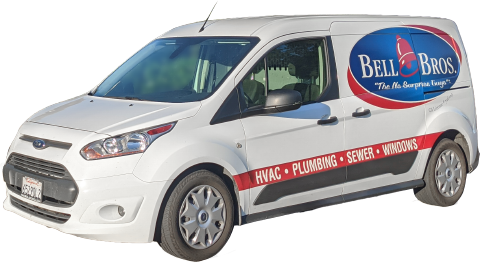The Ultimate Fall Furnace Maintenance Guide: A Checklist for California Homeowners
When fall comes to Northern California, it brings with it a lot of work for the folks who live here. We’re known for our tall, old trees in these parts—Sacramento is even called the city of trees, as most people who live here know—so we have to do our fair share of raking. We also have to do things like clean up our yard, cover our pool, and just generally get ready for our rainy, cold winter that’s about to show up. While we’re busy with all that, though, there’s one part of the house that’s just getting fired up: the furnace (sorry for the fired up pun, but I just couldn’t resist).
Yes, while things like your pool and your yard are getting ready to hibernate for a few months, so to speak, your furnace is getting ready to go to work. It’s your job as a responsible homeowner to make sure that it’s prepared to efficiently do just that. After all, it will be tasked with keeping you and your family warm all winter long. You don’t want to take any chances with that, and that’s why I recommend carefully following a fall furnace maintenance guide—a checklist for the savvy homeowner, if you will.
Simply put, without proper fall maintenance your furnace is at a significantly higher risk of working poorly or shutting down altogether, usually unexpectedly when you need it the most. Don’t take a chance, not when following the simple steps on a fall furnace maintenance checklist is so much easier than calling in a pro mid storm.
Change Your Filter: The First Thing on Your Fall Furnace Maintenance Checklist

- Air flow reduction: If you haven’t change your filter in a while, it’s at risk of getting clogged with debris. When that happens, the air just can’t get through, meaning that the flow of warm air coming out of your vents will ultimately be reduced, leaving your home uncomfortably cold.
- Higher energy bills: Another thing that happens when your filter is old and clogged is that your furnace will run longer than usual because enough warm air won’t be getting through to lower the temperature on your thermostat. This can result in higher than normal monthly electric bills. I haven’t met a homeowner yet who’s okay with that.
- Dust and other allergens get into your home: As I’ve talked about in the past, a clogged or incorrectly-sized filter can mean dust is being spread by your HVAC system. Allergens like pet dander or mold can scatter throughout your home from room to room, ensuring your family is breathing them in.
I know, I know. Making sure your filter is changed and up to date seems like a pretty simple task, but my recommendation is that you enlist the help of a professional heating and cooling service to make sure it gets done. Fall can be a busy time, what with the holidays coming and the kids headed back to school; it can be difficult to remember even something as simple as changing your filter. A trained HVAC pro, though, can help make sure you get the right type of filter for your furnace—and that it stays clean and effective in helping clear your home’s air.
Run Your Furnace to Test It, a Fall Furnace Maintenance Guide Must
Don’t wait until the cold weather is actually upon us to run your furnace for the first time. Chances are you could discover you have a serious problem when you really need your furnace the most. My advice is to pick a somewhat chilly day as the weather starts to turn a bit to test your furnace, when you still have time to get any issues taken care of before the real chilly weather shows up.
Here are some things I advise homeowners to look for:
- Short cycling: Short cycling is when your furnace runs for a short period of time (let’s say three minutes or less) before shutting off. This is a serious problem because it means your home is not being heated properly. It also means your energy bill is liable to be high; a furnace consumes more energy when it turns on and off over and over again instead of running smoothly as needed. Short cycling often indicates problems with the thermostat or a heat exchanger that’s having an issue that causes it to overheat. Either way, it’s time to call an HVAC pro to have it checked out.
- Odd noises: Unusual sounds, like a rumble, pop, or bang when your furnace is running is another problem I’ve talked about in the past. They are all sounds you want an HVAC tech to address because they can indicate a broad range of issues, from a loose blower wheel to unbalanced ductwork. These problems generally start with an odd noise before turning into a full on failure, potentially shutting the whole system down. Again, best to get this one taken care of early.
- Irregular flames: Open your furnace up and look at the flame in there. Is it uneven or leaning toward the back of the unit? If so, it’s time to call in a pro. These are signs of problems that include dirty burners or a cracked heat exchanger, neither of which is something you should try to tackle yourself.
An Annual HVAC Check-Up: Let the Experts Guide Your Fall Furnace Maintenance
This last step is the most important. Simply put, you’re doing your furnace a disservice if you don’t get it a tune up each and every year. I’m sure you ran it quite a bit last winter, which was one of our coldest and rainiest in years. Well, your furnace is kind of like driving a car. If you were about to go on a long road trip, you’d probably have a mechanic change the oil, service the breaks, and make sure everything is in running order either before you left or when you got home.
Don’t forget, your furnace is a complex mechanical system, just like your car’s engine. You want to get it a tune up before putting a significant amount of miles on it.
Don’t forget, your furnace is a complex mechanical system, just like your car’s engine. You want to get it a tune up before putting a significant amount of miles on it. If you don’t, it’ll be far more likely to break down and, like your car, you definitely don’t want it to fail when you’re in the middle of using it. Preventative maintenance by an experienced HVAC tech is a key to a healthy furnace this winter.
So there you have it, a fall furnace maintenance guide, a checklist that, when followed carefully, will squash most minor problems before they turn major. I’m sure you’re a fan of saving money so, take it from me, this kind of preventative maintenance is way easier on the wallet than an HVAC crisis during one of the coldest months.
Go ahead and rake your yard, get the tarp over your pool, and sip cider while enjoying the changing colors of our leaves. But, while you’re at it, pick up the phone and have an experienced HVAC pro out to take care of your furnace, too.
Don’t wait for your furnace to break down. Contact the HVAC professionals at Bell Brothers to schedule your fall maintenance check up today. And, while we’re visiting your home, let us give you a whole house assessment for energy efficiency and offer recommendations and upgrades that are sure to increase your year-round comfort—and decrease your power bills.
Wondering how to finance a new HVAC system, windows, or plumbing? HERO is a unique financing option that helps California homeowners afford energy efficient upgrades to their home. Contact Bell Brothers, a HERO-approved contractor, to learn more. Our local HVAC, plumbing, and window specialists will walk you through the entire process, from applications to installation.
Image courtesy Unsplash user Rachael Gorjestani

